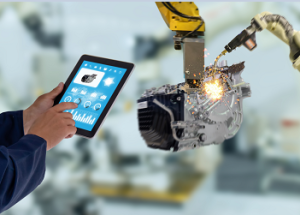
Read this blog to learn more about the advancements in Process Technology, The manufacturing and processing industry trends of today point to five universal goals for the future. They lead to higher quality products that will satisfy consumer and commercial demand to a higher level and include:
- Better security and data collection
- Increased communication between employees
- Improved performance – human and automation
- More efficient production and less waste
- More personalized solutions to market demand
Five emerging trends and innovations in process technology are revolutionizing manufacturing and processing industries. Process technology students should be familiar with them for their technical training and careers. Contact ITI Technical College today for more information.
Artificial Intelligence Advancements In Process Technology
Artificial intelligence (AI) is developing across many global industries including manufacturing and processing facilities. AI has many effective applications for improved performance, more efficient manufacturing, and reliable automation, including:
- Provides visual inspection tools programmed with AI
- Quickly detects defects in production lines
- Enables more consistent manufacturing processes
- Improves maintenance, failure detections, and product quality
- Enables improved procurement of raw materials
- Optimizes quality control and assembly of products
- Improves delivery of products and supply chain management
AI is used to enhance the creativity and accuracy of processes and products. Its data analytics improves predictive automation by improving every cycle step in manufacturing processes. AI also alerts technicians that breakdowns are imminent in real time so they can be restored quickly.
Augmented Reality Advancements
 Augmented reality (AR) and virtual reality (VR) are leading manufacturing innovations. They are used for creating simulations to train workers that are more cost-effective, safer, and easier to improve over time. They are also used for conducting maintenance and designing new production processes. AR and VR improve process technology in these other ways:
Augmented reality (AR) and virtual reality (VR) are leading manufacturing innovations. They are used for creating simulations to train workers that are more cost-effective, safer, and easier to improve over time. They are also used for conducting maintenance and designing new production processes. AR and VR improve process technology in these other ways:
- Design, test, and adjust products before making them in quantity
- Perform assembly of products and maintenance of equipment more accurately
- Help prevent product defects by providing more information about them
- AR can facilitate collaboration between remote teams
- Help employees better understand the environmental impact of their actions
|
“Five emerging trends and innovations in process technology are revolutionizing manufacturing and processing industries. Process technology students should be familiar with them for their technical training and careers.” |
Advancements In Process Technology: Blockchain
Blockchain is a way to store digital data in employee networks that decentralizes data and provides additional network security. It is useful for tracking building materials and related information that provides a more transparent manufacturing process. It also makes it simpler to collect data and information on all inputs for any process a company uses.
Blockchain also provides security that is improved by AI with more efficient attack monitoring and mitigations. Integrating the two creates intelligent systems that are more efficient and error-free transactions. Blockchain enhances AI by accessing large databases from within and without organizations. This improves scalability and provides a more appropriate understanding of processes for technicians. It also provides enhanced transparency and trustworthiness in data sharing and usage.
The Industrial Internet Of Things (IIoT)
The industrial Internet of Things (IIoT) is the manufacturing and processing application of the Internet of Things (IoT). IIoT is used in a variety of applications, such as manufacturing, energy management, logistics, and distribution. It empowers communication between devices that allows every part of processes to synchronize with one another with these advantages:

- Sensors contribute data collected from operations to a shared network
- Sensors are connected to 5G technology to improve efficiency
- Performance and productivity are improved and better understood
- It is easier to monitor automated factories
- Improve safety and security and reduce costs
- Improve troubleshooting and maintenance capabilities
IIoT networks support machine-to-machine communication with AI, machine learning, cloud, mobile, and edge computing. 5G technology enables devices to share data in real-time which improves the effectiveness of processing facilities.
3D Printing Advancements In Process Technology
3D printing is a growing process that uses mechanical layering of materials to build a variety of products, new materials, and architectural models. The process makes it easier to create personalized products for unique consumers or commercial businesses. It provides these pros:
- 3D prints fast and can use multiple materials in a single product
- Creates better quality, smoother surfaces, and sharper edges
- It provides real-time sensor feedback on temperature, humidity, and material flow
- 3D printers integrate surface finish, heat treatment, and precision machining
- Processing can use many different materials to create products
- It can eliminate the need for large inventories by making only what is needed
In summary, students should expect these advancements in process technology and many more in the next five years. Request more information about our Process Technology (AOS) Associate In Occupational Studies Degree.
.
For more information about graduation rates, the median debt of students who completed the program, and other important information, please visit our website:https://iticollege.edu/disclosures/




